Exploring 6 Key Fly Categories & Effective Patterns

Fly fishing is a captivating pursuit that combines skill, patience, and a deep connection with nature. At the heart of this art lies the selection and presentation of the fly. Each category of fly imitates a specific stage of aquatic life, enticing fish to strike. We'll delve into the world of fly fishing, examining the characteristics and popular flies within each category, along with tips on how to use them effectively. Let's cast our lines and embark on this adventure!
Dry Flies
Dry flies imitate adult insects that float or rest on the water's surface. Unlike nymphs or streamers that imitate underwater life stages, dry flies are intended to imitate insects in their adult form. They are typically tied with buoyant materials, such as feathers, hair, or foam, which enable them to float on the water's surface tension. Dry flies are often used when fish are actively feeding on insects at or near the surface. Anglers use precise casting techniques to present the dry fly delicately, allowing it to drift naturally along the water's surface, imitating the behavior of an actual insect. When a fish rises and takes the dry fly, it creates an exhilarating moment for the angler, resulting in a visual and often explosive strike.
Popular Dry Flies:
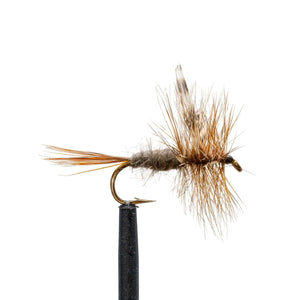 |
1. Adams: The Adams is a classic dry fly pattern that imitates a wide range of mayflies and other insects. It features a dark gray or brown body with a grizzly hackle and a white or gray wing. The Adams is highly versatile and effective, making it a staple in any fly angler's arsenal. It can be used during hatch activity or when fish are actively rising to insects on the water's surface. |
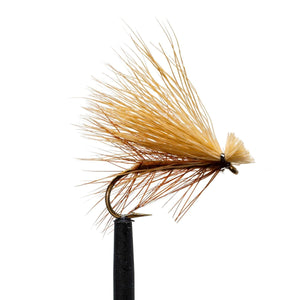 |
2. Elk Hair Caddis: This versatile fly mimics adult caddisflies. It sports an elk hair wing and a dubbed body. The Elk Hair Caddis is an excellent choice for imitating both caddisfly and smaller stonefly species. The Elk Hair Caddis is effective in both rivers and streams, especially during caddisfly hatches. |
 |
3. Royal Wulff: The Royal Wulff is an attractor dry fly pattern that imitates various mayflies and stands out on the water due to its distinctive red body, peacock herl, and white calf hair wing. The Royal Wulff is highly visible and buoyant, making it suitable for fast-moving water or low-light conditions. It is an effective fly for both trout and grayling and can be used throughout the fishing season. |
 |
4. Blue Wing Olive (BWO): The Blue Wing Olive is a must-have dry fly pattern for imitating small mayflies. It features an olive or gray body and a split or upright wing, closely resembling the natural insects. The Blue Wing Olive is effective during BWO hatches or when fish are selectively feeding on small flies. It can be used in both rivers and stillwater environments.. |
 |
5. Royal Stimulator: The Royal Stimulator is a high-floating, buoyant dry fly pattern that imitates a wide range of insects. It features a bushy appearance with a distinct peacock herl body, a grizzly hackle, and a wing made of elk or deer hair. The Royal Stimulator is an excellent attractor pattern that can be used during stonefly and caddisfly hatches. It is particularly effective when fish are actively feeding and looking for larger prey. |
When fishing with dry flies, observe the water for rising fish or insect activity. Match the size, color, and silhouette of the natural insects with your chosen dry fly. Cast upstream or across the current, allowing the fly to land gently on the water. Mend the line to achieve a drag-free drift and monitor for any signs of fish taking the fly. Stay attuned to the natural movements of insects on the water's surface and adjust your presentation accordingly.
Shop All Dry Flies

Nymphs
A nymph imitates the underwater life stages of insects, such as mayfly nymphs, caddisfly larvae, or stonefly nymphs. Unlike dry flies that float on the water's surface, nymphs are designed to sink below the surface and mimic the insects as they develop and grow underwater. Nymphs are typically tied with materials like feathers, fur, and synthetic fibers to imitate the appearance and movement of the natural insects. Anglers use nymphs when fish are feeding beneath the surface or during periods when insect activity is low. Nymphing techniques involve presenting the fly near the bottom of the water column and utilizing indicators or weighted lines to detect strikes. Nymph fishing requires a good understanding of aquatic insect behavior and the ability to effectively control the drift of the fly to entice strikes from feeding fish.
Popular Nymphs:
 |
1. Pheasant Tail: The Pheasant Tail nymph is a versatile and effective pattern that imitates a variety of aquatic insects. It features a slender body made of pheasant tail fibers and a thorax covered with peacock herl. The Pheasant Tail nymph can be used to imitate mayfly nymphs, midges, and even small stoneflies. It is particularly effective when fish are feeding near the bottom of the water column. |
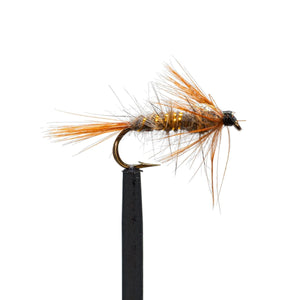 |
2. Flash Back Hare's Ear: The Flashback Hare's Ear nymph is a popular pattern that imitates both mayfly and caddisfly nymphs. It features a shaggy body made of hare's ear dubbing and a shiny flashback wing case. The Flashback Hare's Ear nymph is effective in both stillwater and river environments, especially during mayfly and caddisfly hatches. |
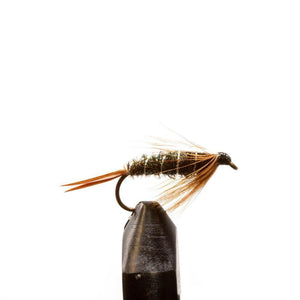 |
3. Prince Nymph: With its flashy appearance, the Prince Nymph is an excellent attractor pattern. Its peacock herl body, white biots, and bead head make it a reliable choice for imitating stonefly nymphs and other aquatic insects. This fly is highly versatile and works well in various water conditions. It can be used as a searching pattern or during times when fish are actively feeding on nymphs. |
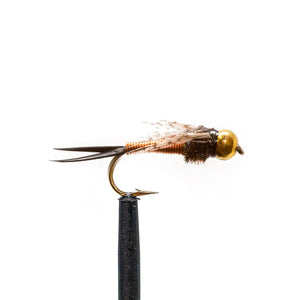 |
4. Copper John: The Copper John is a weighted nymph pattern that imitates mayfly and stonefly nymphs. It features a copper-colored body, a flashy wing case, and a bead head. The Copper John is particularly effective in deeper water or fast-flowing streams where it can reach the desired depth quickly. It is known for its effectiveness in catching trout. |
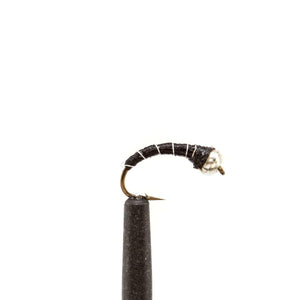 |
5. Zebra Midge: The Zebra Midge is a simple but deadly pattern that imitates midge larvae. It typically features a slender body made of thread or wire and is tied in various colors such as black, red, or olive. The Zebra Midge is effective when fish are selectively feeding on small insects and can be used in both rivers and stillwater environments. |
When fishing with nymph patterns, it's crucial to match the size, color, and behavior of the natural nymphs in the water. Use an appropriate indicator, weight, or leader setup to achieve the desired depth and drift. Focus on presenting the fly near the bottom, as that's where nymphs are most active. Pay attention to the movements and behaviors of fish to determine the most effective nymphing technique and adjust your presentation accordingly. By mastering the art of nymph fishing, you can tap into the abundant food sources below the surface and increase your chances of enticing strikes from trout and other freshwater fish.
Shop All Nymphs
Streamers
Streamers imitate small baitfish, minnows, or other aquatic creatures that swim actively in the water. Streamers are typically larger and bulkier than dry flies or nymphs and are designed to provoke aggressive strikes from predatory fish, such as trout, bass, or pike. They are tied using materials like feathers, fur, and synthetic fibers to create a lifelike profile and movement in the water. When fishing with streamers, anglers use casting techniques that allow the fly to mimic the movement of a fleeing or wounded prey. The retrieval methods vary, ranging from slow strips to fast jerks, imparting an erratic action to the streamer and triggering predatory instincts in fish. Streamer fishing can be particularly effective in rivers, lakes, or when targeting larger fish that actively hunt for prey.
Popular Streamers:
 |
1. Wooly Bugger: The Wooly Bugger is a versatile and widely used streamer fly. Its marabou tail, hackle, and chenille body create a lifelike profile in the water. You can fish it by casting upstream and letting it sink before retrieving it with short, quick strips. Vary the speed and depth to imitate a fleeing or wounded baitfish. |
 |
2. Clouser Minnow: The Clouser Minnow is an excellent streamer for both freshwater and saltwater fishing. It features a lead dumbbell eye near the head, which causes the fly to dive and jig in the water. Cast the Clouser Minnow across the current and retrieve it with steady strips, allowing it to dart and swim enticingly. |
 |
3. Muddler Minnow: The Muddler Minnow is a classic pattern known for its buoyancy and fish-attracting qualities. Its spun deer hair head imitates the profile of a small fish or sculpin. Fish it by casting near banks, structure, or undercut banks and retrieve it with short, erratic strips, imitating a distressed or disoriented prey. |
 |
4. Zonkers: The Zonker is a streamer fly that imitates a variety of baitfish species. It consists of a strip of fur or synthetic material wound around the hook shank. Cast the Zonker near structure or along drop-offs, and retrieve it with a mix of slow strips and occasional pauses to mimic the movement of injured prey. |
 |
5. Sex Dungeons: The Sex Dungeon is a large, articulated streamer that has gained popularity among anglers targeting trophy-sized fish. Its multi-segmented body and flashy materials create a substantial profile and attract predators. Cast the Sex Dungeon towards deep pools or near cover, and retrieve it with aggressive strips to trigger predatory strikes from big fish. |
Remember, streamer fishing techniques can vary depending on the specific conditions and the behavior of the fish. Experiment with different retrieval speeds, pauses, and depths to find the most effective presentation for each streamer fly.
Shop All Streamers

Emergers
An emerger imitates the stage of an insect's life cycle when it is transitioning from its nymphal form to its adult form and emerging from the water's surface. Emergers are designed to imitate the vulnerable and often helpless insects as they struggle to break free from their nymphal shucks and reach the surface. These flies are typically tied with materials that imitate the trailing legs, wings, and emerging body of the insect.
Popular Emergers:
 |
1. RS2 (Rim's Semblance 2): The RS2 is an effective emerger pattern that imitates a variety of emerging insects, including mayflies and midges. It has a sparse, slim profile and is usually fished in smaller sizes. Present the RS2 using a dead-drift technique, allowing it to drift naturally in the water column to imitate an emerging insect in the surface film. |
 |
2. Beadhead BWO Emerger: The Beadhead BWO Emerger is designed to imitate the emerging stage of Blue Winged Olive (BWO) mayflies. It features a beadhead to add weight and a slim body profile. |
 |
3. Elk Wing Emerger: The Elk Wing Emerger imitates the stage of an insect's life cycle when it is transitioning from its nymphal form to its adult form. It features an elk hair wing that adds buoyancy and natural movement to the fly. |
 |
4. WD40: The WD40 is a simple yet effective emerger pattern that imitates a variety of emerging insects. It is usually tied in smaller sizes with a sparse body and trailing shuck. Fish the WD40 in slower-moving water or during selective feeding situations. Use a dead-drift presentation or add slight twitches to imitate the emerging insect. |
 |
5. Black Soft Hackle: The Black Soft Hackle is a versatile emerger pattern that imitates various emerging insects. It typically consists of a body made of dubbed or synthetic materials and a soft hackle collar for added movement. |
When fishing with emergers, observe the water for signs of insect activity, such as rising fish or floating nymphal shucks. Match the size, color, and behavior of the natural insects with your chosen emerger pattern. Pay attention to the drift and presentation, aiming for a natural and convincing imitation of the struggling or emerging insect.
Shop All Emergers
Wet Flies
A wet fly is designed to be fished beneath the water's surface. Unlike dry flies that imitate insects on the surface or nymphs that imitate underwater stages, wet flies imitate a variety of aquatic insects, baitfish, or other small creatures that are actively swimming or drifting in the water column. Wet flies are typically tied with soft materials like feathers, fur, or synthetic fibers to create a lifelike profile and movement.
Popular Wet Flies:
 |
1. Adams Wet: The Adams Wet is a variation of the classic Adams dry fly, but tied as a wet fly. It imitates various mayfly species and features a dark gray or brown body, a grizzly hackle, and a white or gray wing. The Adams Wet is fished below the water's surface and is effective when fish are feeding on submerged insects. Use a dead-drift or swing presentation to imitate the movement of an emerging or drowned mayfly. |
 |
2. Blue Dun Wet: The Blue Dun Wet is a wet fly pattern that imitates the nymphal or emerging stage of mayflies. It typically features a bluish-gray body, a soft hackle collar, and a slim profile. Fish the Blue Dun Wet by presenting it near the bottom using a dead-drift or swing technique. It is particularly effective during mayfly hatches or when fish are actively feeding on nymphs in the water column. |
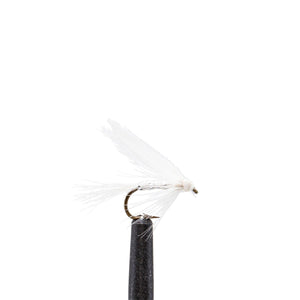 |
3. White Miller Wet: The White Miller Wet is a wet fly pattern that imitates caddisfly species commonly known as the "White Miller." It usually has a white or cream body, a soft hackle collar, and sometimes a sparse wing. Fish the White Miller Wet by presenting it near the surface or just below, using a dead-drift or swing technique. It can be effective during caddisfly hatches or when fish are targeting emerging caddisflies. |
 |
4. March Brown Wet: The March Brown Wet is a wet fly pattern that imitates the nymph or emerger stage of the March Brown mayfly. It typically features a brown or tan body, a soft hackle collar, and a slim profile. Fish the March Brown Wet by presenting it near the bottom using a dead-drift or swing technique. It is effective during the March Brown mayfly hatch or when fish are actively feeding on nymphs in the water column. |
 |
5. Coachman Wet: The Coachman Wet is a classic wet fly pattern that has been used for generations. It is an attractor pattern that imitates a variety of insects and features a peacock herl body, a red or brown hackle collar, and sometimes a wing. Fish the Coachman Wet by presenting it near the surface or just below, using a dead-drift or swing technique. It can be effective when fish are selectively feeding on a variety of insects or during times of low insect activity. |
When fishing with wet flies, adapt your techniques based on the specific conditions and the behavior of the fish. Vary your retrieves, depths, and presentation speeds to find the most effective approach. Experiment with different wet fly patterns to match the prevalent insects in your fishing area and observe the reactions of the fish to refine your strategy.
Shop All Wet Flies
Eggs & Worms
Eggs and worms imitate specific food sources for fish. Eggs imitate the eggs of spawning fish, particularly trout or salmon, while worms imitate aquatic worms or annelids that fish feed on. These patterns are particularly effective during certain seasons or when fish are actively feeding on these protein-rich food sources.
Popular Egg & Worm Patterns:
 |
1. Glo Bugs: The Glo Bug is a well-known and effective egg fly pattern. It is tied with yarn in various colors to imitate different stages of fish eggs. Fish the Glo Bug by drifting it near the riverbed, using indicators or a tightline nymphing technique to detect subtle strikes. |
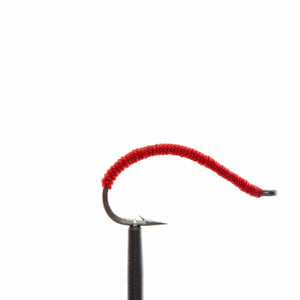 |
2. San Juan Worm: The San Juan Worm is a classic and highly effective pattern that imitates aquatic worms found in rivers and lakes. It is typically tied with chenille or worm-like materials in various colors such as red, pink, or brown. Fish the San Juan Worm by drifting it near the bottom of the water column, using a dead-drift presentation or occasional twitches to imitate the movement of a worm in the water. |
 |
3. Double Bead Ultra Worm: The Double Bead Ultra Worm is a highly effective worm pattern for fly fishing. It features two weighted beads on the hook shank, providing added weight and allowing it to sink quickly. The body is typically made of chenille or worm-like material, and it can be tied in various colors such as red, pink, or brown. The Double Bead Ultra Worm is a versatile pattern that imitates aquatic worms or annelids found in streams and rivers. It is particularly effective when fish are feeding near the riverbed or in deeper waters. Use a dead-drift presentation or a slow retrieve to mimic the natural movement of a worm. |
 |
4. San Juan Wire Worms: The San Juan Wire Worm is a classic worm pattern that has proven its effectiveness over time. It typically features a body made of wire, which gives it a segmented appearance and adds weight for sinking. The San Juan Wire Worm is commonly tied in red, pink, or brown colors, imitating the natural colors of worms. This pattern is highly effective when fish are feeding on worms or in situations when other flies are less successful. Fish it near the bottom using a dead-drift or a slow retrieve to imitate the movement of a worm. It can be used in both rivers and stillwater environments. |
 |
5. Blood Dot: The Blood Dot is a simple and effective egg pattern tied with a small bead or a dot of red thread. The red dot represents the blood spot found in some fish eggs. Fish the Blood Dot by drifting it near the riverbed or using a slow swing or twitching motion to imitate dislodged eggs. |
When fishing with egg patterns or worm patterns, it is crucial to match the prevailing color, size, and behavior of the natural eggs or worms in the water. Adjust the weight or indicator to achieve the desired depth and allow the fly to drift naturally with the current. Observe the behavior and feeding patterns of fish to determine the most effective presentation style. Both eggs and worms can be highly effective during specific seasons or when fish actively feed on them as a protein-rich food source. Whether you're imitating eggs during spawning seasons or presenting worms near the bottom, paying attention to fish behavior and adapting your technique accordingly will increase your chances of success.
Shop All Eggs
Shop All Worms

Each category of fly imitates a specific stage of aquatic life, enticing fish to strike. From the delicate drift of a dry fly on the water's surface to the enticing movement of a streamer below the surface, fly fishing offers a range of techniques to entice and fool fish. Nymphs, emergers, wet flies, and egg patterns each have their unique characteristics and methods of use. By understanding the behavior of the fish and the prevalent insect life, anglers can select the appropriate fly and employ the right techniques to entice strikes. Whether casting delicate dry flies during a hatch, presenting realistic nymphs to feeding fish, or swinging streamers through deep pools, the angler's skills are put to the test. Each cast brings the possibility of a thrilling visual take and the satisfaction of connecting with a fish.
RELATED ARTICLES:
- JHFLYCO Spring Fly Guide
- 8 Spring Fly Fishing Tips for Landing Your Dream Trout
- 6 Late Summer Fly Fishing Tactics
- 20 Essential JHFLYCO Winter Fly Patterns
- JHFLYCO Late Winter Fly Guide







